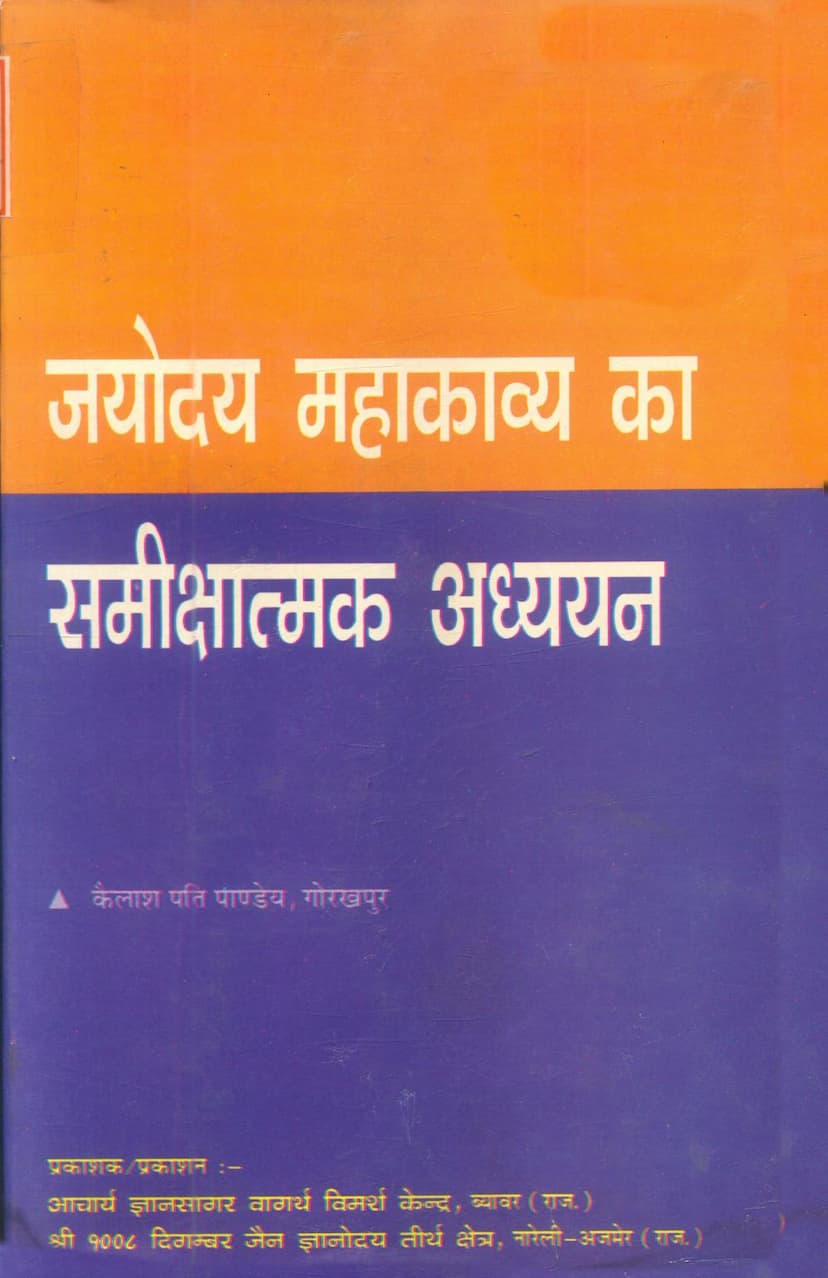Jayoday Mahakavya Ka Samikshatmak Adhyayan
Added to library: September 2, 2025

Summary
This is a comprehensive summary of the "Jayoday Mahakavya Ka Samikshatmak Adhyayan" (A Critical Study of the Mahakavya Jayodaya) by Kailash Pandey, published by Gyansagar Vagarth Vimarsh Kendra. The study focuses on the "Jayodaya Mahakavya," a significant work by Mahakavi N. Pt. Bhuramal Shastri (Acharya Gyan Sagar Ji).
The book is presented as a research thesis approved for a Ph.D. degree from Gorakhpur University. It was inspired by and dedicated to Acharya Shri Vidyasagar Ji Maharaj and his disciple Muni Shri Sudhasagar Ji Maharaj. The publication was supported by the Acharya Gyan Sagar Vagarth Vimarsh Kendra and Shri Digambar Jain Gyanodaya Teerth Kshetra, Nareli-Ajmer.
Key aspects covered in the book:
-
Introduction to Mahakavi Acharya Shri Gyan Sagar Ji Maharaj:
- His literary contributions include several Mahakavyas (epic poems) in Sanskrit and numerous works in Hindi on Jain philosophy, principles, and spirituality.
- His life journey included embracing Brahmacharya and later Muni Deeksha. He was a prolific writer and deeply contributed to enriching Jain literature.
- His works covered a wide range of topics, including the glorification of Jain Tirthankaras, philosophical treatises, devotional hymns, and practical guides.
-
Detailed Analysis of "Jayodaya Mahakavya":
- Author and Context: The book is a critical study of the "Jayodaya Mahakavya," authored by Mahakavi Bhuramal Shastri (Acharya Gyan Sagar Ji). It was completed by Kailash Pandey as his Ph.D. thesis.
- The Mahakavya: "Jayodaya" is described as a vast epic poem of 28 cantos (Sargas) that adheres to the conventions of classical Sanskrit Mahakavyas.
- Narrative: The central story revolves around Prince Jayakumar and Princess Sulochana. It details their love story, the challenges they face, including conflicts with Prince Arkeerti (son of Emperor Bharat), their eventual union, and Jayakumar's eventual renunciation and spiritual journey, culminating in his attainment of liberation (Moksha).
- Themes: The Mahakavya explores themes like Dharma, Artha, Kama, and Moksha (the four aims of life), Ahimsa (non-violence), Aparigraha (non-possession), the importance of righteous conduct, and the spiritual path as advocated in Jainism.
- Literary Merit: The study analyzes the Mahakavya's literary qualities, including:
- Poetic Style (Riti): The book discusses the presence of various Sanskrit poetic styles (Ritis) like Vaidarbhi, Gaudi, Panchali, and Latika, highlighting their usage in different contexts within the poem.
- Emotions (Rasa): It examines the skillful depiction of various emotions (Rasa), such as Shringar (love), Veera (heroism), Karuna (pathos), Raudra (anger), and importantly, Shanta (peace/serenity) as the dominant or underlying emotion guiding the protagonist's journey.
- Figures of Speech (Alamkara): A significant portion is dedicated to the analysis of numerous figures of speech employed by the poet, including Upama (simile), Rupaka (metaphor), Shlesha (pun), Vakyavritti (allusion), Bhrantiman (misconception), Atishayokti (hyperbole), Virodha (paradox), Vyathirek (contrast), and others. The study demonstrates the poet's mastery in employing these literary devices to enhance the narrative and aesthetic appeal.
- Prosody (Chhanda): The book details the various meters (Chhandas) used throughout the Mahakavya, such as Upendravajra, Indravajra, Upajati, Anuṣṭubh, Arya, Drutavilambita, Shardula Vikridita, Vasantatilaka, Malini, Vamshastha, and others, noting their appropriate application to convey specific moods and actions. The study highlights the poet's technical expertise in prosody.
- Sound Devices (Dhvani): The analysis also touches upon the use of "Dhvani" (suggested meaning or resonance) in the poetry, further enhancing its aesthetic and philosophical depth.
-
Sources and Historical Context:
- The study identifies Acharya Jinasen's "Adi Purana" as a primary source for the narrative of Jayakumar and Sulochana.
- It also mentions potential influences from other Jain and even Vedic traditions, noting the poet's broad knowledge.
-
Critical Evaluation:
- Pandey's study evaluates the Mahakavya based on the established criteria of Sanskrit Mahakavyas, as defined by scholars like Vishwanath Kaviraj in "Sahitya Darpana."
- While appreciating the Mahakavya's adherence to classical form, rich vocabulary, and the poet's profound knowledge of various disciplines (grammar, philosophy, music, astrology, politics), the study also points out some minor shortcomings, such as occasional linguistic irregularities or complex word choices that might pose difficulty for the reader.
- The study acknowledges the influence of earlier poets like Kalidasa, Bharavi, Magha, and Shri Harsha on Acharya Gyan Sagar Ji's style but emphasizes that "Jayodaya" possesses its own unique merit and stands as a significant contribution to Sanskrit literature, particularly within the Jain tradition.
-
Significance:
- The book highlights the rich contribution of Jain scholars to Sanskrit literature.
- It aims to bring to light the literary excellence of Acharya Gyan Sagar Ji and his monumental work, "Jayodaya Mahakavya," to a wider audience.
- The study also implicitly promotes the revival and appreciation of classical Sanskrit Jain literature.
In essence, "Jayodaya Mahakavya Ka Samikshatmak Adhyayan" is a scholarly and detailed examination of a significant Jain Mahakavya, providing insights into its narrative, literary techniques, philosophical underpinnings, and the scholarly achievements of its author, Mahakavi Acharya Gyan Sagar Ji.